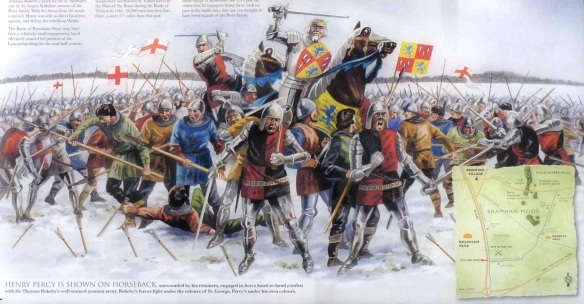Although he had lost a brother and a son, Henry Percy’s hatred of Bolingbroke and desire for revenge drove him on. A new phase of rebellion saw the Archbishop of York, Richard le Scrope, lead a failed rising in northern England in 1405. Scrope and other rebel leaders were executed, but the Earl of Northumberland continued to lead a charmed life, fleeing this time to Scotland.
Three years later, the Earl was back, invading northern England with Lowland Scots and loyal Northumbrian retainers. But this was to be the end-game of the long-running Percy Rebellion.
In December 1407, Percy crossed the Tweed with his ally Thomas, 5th Baron Bardolph. Hugging the coast, they arrived at the Percy dynasty’s ancient bastion of Seamer in the first week of January, intending to strike west towards Tadcaster, where Percy expected to join forces with the High Sheriff of Yorkshire, Sir Thomas Rokeby. What Percy did not know was that Rokeby remained loyal to the King: the Earl was being lured into a trap.
By the end of January, the Earl had arrived at Thirsk, where he proudly declared himself England’s saviour and urged all right-thinking men to join him and help rid England of Bolingbroke, the usurper. Although the call was heeded by some, no men of note joined, leaving Percy with a ragtag army of smiths, tailors, falconers, mercers, artisans, and countrymen. Crucially, there was little military experience.
By mid-February, Percy had been informed of Rokeby’s betrayal. The Sheriff had crept around Tadcaster and was lying in wait outside Knaresborough. Percy managed to avoid him, arriving safely at Wetherby on the night of the 18 February. FromWetherby, the road to the Midlands and the south lay open. But Rokeby was working hard to catch up with Percy. This he did the next day.
At Bramham Moor, close to Bramham Park, south of Wetherby in Yorkshire, Percy’s army was met by a force of local Yorkshire levies and noble retinues, which had been hastily assembled to meet it. The man Percy thought would be on his side, Sir Thomas Rokeby, led the opposing army.
During the `Great Frost and Ice’ of 1407-1408, as it was dubbed, the Moor was no place to fight a battle, with thick snow and an icy wind – but fight they did.
The exact sizes and compositions of the opposing armies are not known, but the armies were far smaller than the thousands who had gathered at Shrewsbury, the rebels having failed to gain widespread support or receive aid from other anti-Lancastrian factions, notably in Wales, where Glyndŵr’s rebellion was finally collapsing.
The course of the battle is not well documented: this is one of England’s lesser-known engagements. The action seems to have followed the course of many medieval battles where armies and generals were evenly matched, taking the form of a violent melée in the centre of the field with little tactical direction.
Percy is said to have positioned his men carefully and awaited Rokeby’s arrival in the early afternoon, when battle was instantly joined. Apparently, Rokeby did not bother to negotiate, ordering his forces straight into the attack. There were no chivalric niceties, no liveried men-at-arms making a grand display; Bramham Moor was just a nasty, messy, headlong collision.
What we do know is that Percy was defeated, and the Earl himself finally met his end fighting a furious rearguard action as his army was routed. It is believed that he was unhorsed and suffered a wound to one of his limbs, after which he was cut down by Rokeby’s knights. His ally Bardolph was mortally wounded early in the action, allegedly by a lance to the neck, and died that night. The battle, by all accounts, lasted barely an hour and a half.
Very few of the Earl’s soldiers escaped and returned to Scotland, though Rokeby seems not to have ordered a cavalry pursuit. He was content with his prize: the power of the Percy family had been shattered.
After the battle a number of the rebels were executed, including the Abbot of Hailes, near Gloucester, who was caught dressed in full armour. The Bishop of Bangor was spared because he was wearing his vestments.
The Earl’s body suffered the same fate as Hotspur’s, but the quarters were eventually gathered up and he was buried alongside his nephew in York Minster on 2 July 1408.
